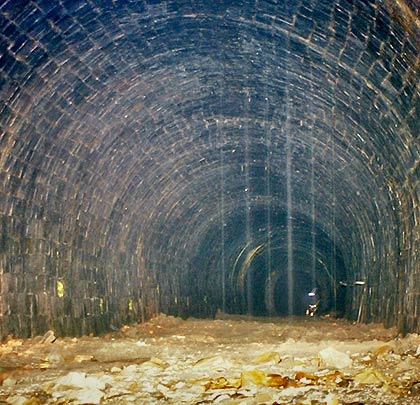Burbage Tunnel
Burbage Tunnel






















The Cromford & High Peak Railway (C&HPR), originally planned by Josias Jessop, was executed under the direction of engineer Thomas Woodhouse. The estimated cost of £164,000 proved to be woefully short of the mark.
An act was obtained in May 1825 with the objective of creating a waterway to connect the Cromford and Peak Forest canals. Due to the mountainous and rugged nature of the landscape between them – involving an easterly ascent of 992 feet and western descent of almost 800 feet – the scheme was soon revised in favour of a railway.
Whilst the hills were generally conquered using rope-worked inclined planes, Burbage Edge to the west of Buxton was pierced by a tunnel. Costed at £5,700 in 1824, the structure was driven from its two ends, without any intermediate shafts being sunk. Gunpower was used to blast through the hard clunch or shale strata.
21 feet wide and 16 feet high, it was the longest of three tunnels on the C&HPR’s original alignment at 580 yards. Together with a small cutting at nearby Ladmanlow, the total volume of material excavated amounted to 62,000 cubic yards. The structure was lined throughout with masonry and accommodated a single track. It opened on 6th July 1831, just over a year after the Cromford Wharf to Hurdlow section had seen its first traffic.
Initially horse-drawn between the inclines, steam locomotives were first used to haul trains along the line in 1833. The route’s northern section – including the tunnel – was abandoned on 25th June 1892 after its then owner, the London & North Western Railway, opened a new connection into Buxton from Harpur Hill.
Today the tunnel is secured at both ends, with the original concrete barriers being replaced with walls of brick at the south end and stone at the north. Material for the latter was obtained by dismantling the portal. Now very wet and with considerable distortion in places, the tunnel is used by BT to carry a communications cable. This is laid in a concrete trough down the centre line.







